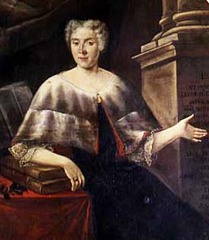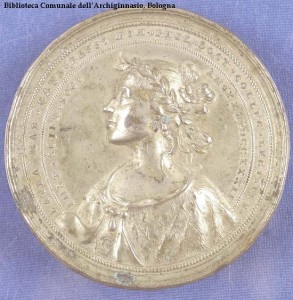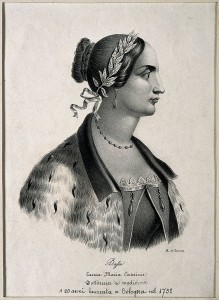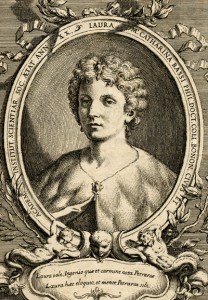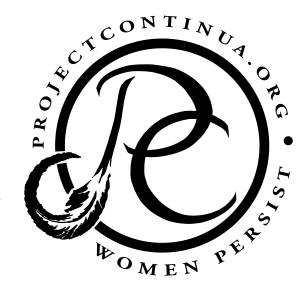- Portrait of Italian mathematician and physicist Laura Bassi (1711-1778) by Carlo Vandi (18th century)
- Silver Metal, Biblioteca Comunale dell’Archiginnasio, Bologna
- Laura Maria Caterina Bassi. Lithograph by A. di Lorenzo.
- Italian physicist Laura Bassi
Laura Bassi (1711–1778) Laura Bassi’s achievements as experimental scientist, professor, wife, and mother were unprecedented, even in 18th Century Italy which enjoyed a unique tradition of learned women. Bassi was unusual in being from a middleclass family. She was educated at home by a male tutor who provided traditional training in Aristotelian and Cartesian thought. She demonstrated her intellectual independence when she decided to investigate the new field of Newtonian physics.
In 1732, Bassi defended her Latin theses in a ceremony that conferred the degree of Doctor at the University of Bologna. The university recognized the importance of the event with miniature paintings decorating official documents. A silver coin was created in her honor that linked her with the Roman goddess of learning, Minerva. Political and religious figures attended the ceremony, including Cardinal Prospero Lambertini, the future Pope Benedict XIV, her strong supporter. Bassi was granted an academic lectureship in universal philosophy at the Institute and Academy for Sciences and Arts of Bologna, but was not allowed to teach in public without approval from her male colleagues. They worried about creating a precedent that would encourage other women to aspire to careers as teachers, as well as the daily presence of a young woman among them. Bassi responded by marrying physician Giuseppe Veratti. She explained her decision: “I have chosen a person who walks the same path of learning, and who from long experience, I was certain would not dissuade me from it.”
The couple shared domestic life, professional work, and intellectual curiosity. They set up a laboratory in their home where they conducted experiments, particularly on the effectiveness of electric therapy. They also ran a private school of experimental physics that Bassi managed from 1749 –1778. This allowed her to teach experimental physics, an opportunity denied her by the University. Her courses attracted young students as well as adults interested in Newtonian science.
Bassi’s knowledge of physics and mathematics, combined with her pioneering training in Newtonianism, counterbalanced the traditional approaches of her colleagues at the Institute. As a result, her private courses filled the academic void left by the Institute, offering students innovative experimental physics classes and, equally importantly, she became a key figure in the diffusion of Newtonian science in Italy. In 1750, she requested a pay increase in recognition of her commitment to teaching experimental physics at home. In 1759, she was granted the increase. In 1745 Pope Benedict XIV created a new membership within the Institute of Sciences, the Benedettini, with the goal to stimulate new scientific research in Bologna, on the model of the Paris Academy of Sciences. Twenty-four academics were accepted among the Benedettini and a stipend of 50 lire was rewarded to them on the condition that they present one dissertation per year based on new scientific work. Bassi was not among the twenty-four appointed by the Pope. She petitioned an influential friend to lobby the Pope to include her, too. The Pope created a twenty-fifth place among the Benedettini for Bassi.
Bassi was denied full participation within the Benedettini because, as one wrote, “to be always alone in the midst of an assembly of men, and to hear all their discourses and quarrels, doesn’t seem to befit the decency and modesty of her sex.” Bassi had just given birth to her fifth of eight children when the discussions for her appointment took place.
When the position opened for a new Chair of Experimental Physics, Bassi proposed her candidature, and in 1776 was named Chair and Institute Professor of Experimental Physics, with Veratti as her assistant. She was sixty-five years old. She died suddenly two years later in 1778. Her husband succeeded to the Chair and was followed by their son Paolo, who served until 1796.
The University of Bologna was known as the most progressive university in Europe by allowing the presence of women, especially those versed in the latest mathematical and experimental philosophies. Voltaire recognized this in a letter to Bassi in 1744. ”There is no Bassi in London,” he wrote, “and I would be much happier to be added to your Academy of Bologna than to that of the English, even though it has produced a Newton.”
Laura Bassi’s accomplishments demonstrated that women could be educated in Mathematics and the Physical Sciences and go on to be successful teachers and scientific researchers.
Video by Gina Luria Walker and Kaitlin Sansoucie.
Bibliography:
Algarotti, F. Il newtonianismo er le dame, ovvero Dialoghi sopra la luce, i colori, e l’attrazione. Napoli Venezia, 1739.
Battista Comelli, Giovanni. “Laura Bassi e il suo primo trionfo”, Studi e Memorie per la Storia dell’Università di Bologna, III (1912): 1-60.
Berti Logan, Gabriella. “The Desire to Contribute: An Eighteenth Italian Woman of Science”, American Historical Review, 99 (1994): 785-812.
Ceranski, Beate. “Il carteggio tra Giovanni Bianchi e Laura Bassi, 1733-1745” Nuncius 9 (1994): 207-231.
—. “Und Sie fürchtet sich vor niemanden”. Über die Physikerin Laura Bassi (1711-1778) Frankfurt-New York, Campus Verlag, 1996.
Cavazza, Marta. “Dottrici” e lettrici dell’Università di Bologna nel Settecento.” Annali di storia delle università italiane. 1 (1997): 109-125.
—.“Laura Bassi e il suo gabinetto di fisica sperimentale: realtà e mito.” Nuncius. 10 (1995): 715-753.
—.“Laura Bassi “maestra” di Spallanzani, in Il cerchio della vita. Materiali di ricerca del Centro studi Lazzaro Spallanzani di Scandiano sulla storia della scienza del Settecento.” a cura di W. Bernardi e P. Manzini. Firenze, Olschki, 1999: 185-202.
—. Settecento inquieto. Alle origini dell’Istituto delle scienze di Bologna. Bologna, Il mulino (1990): cap. VII.
Cazzani, Pietro. “Iconografia di Laura Bassi”, in Studi e inediti per il primo centenario dell’Istituto Magistrale “Laura Bassi” Bologna, 1960: 43-52.
Elena, Alberto. “In lode della filosofessa di Bologna”. An Introduction to Laura Bassi” Isis 82 (1991): 510-18.
Findlen, Paula. “Science as a Career in Enlightenment Italy. The Strategies of Laura Bassi” Isis 84, (1993): 441-469.
—. “The Scientist’s Body: The Nature of a Woman Philosopher in Enlightenment Italy”, in Lorraine Daston, Gianna Pomata (eds.), The Faces of Nature in Enlightenment Europe, Berlin, BWV – Berliner Wissenschafts Verlag (2003), pp. 211-36.
Hays, Mary. Female biography, or, Memoirs of illustrious and celebrated women of all ages and countries (6 volumes). London: R. Phillips, 1803.
Melli, Elio. (a cura di), “Epistolario di Laura Bassi Verati”, in Studi e inediti, cit.: 53-187.
—,“Laura Bassi Verati: ridiscussioni e nuovi spunti”, in Alma Mater studiorum. La presenza femminile dal XVIII al XX secolo. Ricerche sul rapporto donne/cultura universitaria nell’Ateneo Bolognese. Bologna, CLUEB, 1988: 71-80.
Noble, David F. A World Without Women. The Christian Clerical Culture of Western Science. New York, Knopf, 1992.
Toschi Traversi, Lucia. “Verso l’inserimento delle donne nel mondo accademico”, in Alma Mater Studiorum, cit.: 15-37.
Primary Sources
Bassi-Veratti Collection – The online Bassi-Veratti Collection consists of an online interface offering access to the digitized versions of all of the materials of the Bassi-Veratti Collection at the Archiginnasio in Bologna. http://bv.stanford.edu/
Laura Bassi, Marta Cavazza and Paola Bertucci, Editors, Miscellanea, (Bologna, 1732), Digital Edition, 2003, 1-125, Dept. of Philosophy, University of Bologna. Accessed Dec. 3, 2014, http://137.204.24.205/cis13b/bsco3/intro_opera.asp?id_opera=31
Resources:
Brooklyn Museum
Elizabeth A. Sackler Center for Feminist Art: The Dinner Party: Heritage Floor: Laura Bassi
http://www.brooklynmuseum.org/eascfa/dinner_party/heritage_floor/laura_bassi.php
Tags: Educators, Enlightenment, Europe, Scientists
